Some stunning hybrid soap can be made by combining two different types of soaps into one artistic bar. The problem is, how do you figure out the ingredient declaration when you have a CP (cold process) soap with MP (melt & pour) soap embeds, or vice versa?
Thanks to the members of the Handcrafted Soap and Cosmetic Guild who provided images of hybrid soaps for this article. For more amazing soaps from HSCG Members, check out the HSCG Soap Gallery.
First, How Much of Each Type of Soap?

To start with, we need to know the percentage of CP soap and the percentage of MP soap in the final product. For our calculations, we’ll have 109.5 oz of CP soap and 10 oz of MP soap (a total of 119.5 oz) in the final, cured batch.
You get the percentage by dividing the amount of one ingredient by the total amount. So 109.5 oz of CP soap, divided by 119.5 oz total = .92 or 92% (rounded).
| Soap | Ounces | Percent |
| CP Soap (main bar) | 109.5 | 92% |
| MP Soap (embeds) | 10 | 8% |
| Total | 119.5 |
Second, the CP Soap
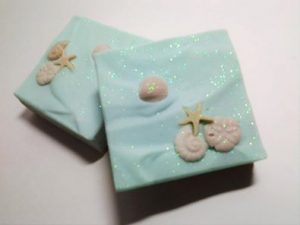
Next, you need to know the amount of each ingredient in the CP soap recipe, the percentage of the CP portion of the soap, and the percentage in the total amount of soap (both kinds).
- The percentage in the CP soap is calculated by the number of ounces of the ingredient divided by the total number of ounces in the recipe.
- The percentage of the total is the percentage of that ingredient in the CP soap multiplied by the percentage of that CP soap in of the whole batch (92%).
Note that for these calculations, I am using the estimated amount of water in the soap AFTER the cure. (For how to estimate the amount of water after the cure, see Calculating the Net Weight of Soap.)
| Ingredient | Ounces | % of CP | % of Total |
| Coconut Oil | 30 | 27.4% | 25.2% |
| Olive Oil | 30 | 27.4% | 25.2% |
| Palm Oil | 25 | 22.8% | 21.0% |
| Castor Oil | 3.5 | 3.2% | 2.9% |
| Sodium Hydroxide | 13 | 11.9% | 10.9% |
| Water (reduced from 26 oz) | 8 | 7.3% | 6.7% |
| Total | 109.5 |
Third, the MP Soap
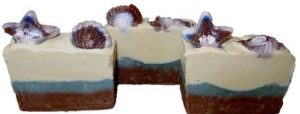
Next, you need to get or figure out the percentage of each ingredient in the MP soap.
I haven’t found one supplier that provides the actual ingredient percentages in MP soap—they hold that information pretty close to the chest as their “trade secrets.” If they won’t provide you with sufficient information, you’ll need to figure it out yourself as best you can. It’s not ideal, but it’s better than having a completely non-compliant ingredient declaration.
For this example, I found a relatively easy MP soap formulation to dissect. The ingredient declaration reads: Coconut Oil, Palm Oil, Safflower Oil, Glycerin, Water, Sodium Hydroxide, Sorbitol, Propylene Glycol, Sorbitan Oleate and Oat Protein.
Let’s see what we can figure out.
Oils, Lye and Water
This particular MP soap is made up of saponified oils of coconut, palm, and safflower, in that order. To calculate the amount of lye and water, you have to work backward.
First, in order to saponify oils, you need a lye solution (lye and water) that is at least 50/50. That’s considered “low water” for CP soap, but for MP it is likely right around the range actually used. That jives with the ingredient list, so we’ll say that there is the same amount of lye as there is water.
Safflower oil needs about 13.7% (of its weight) in both lye and water to saponify. Palm oil needs about 14.2% and coconut oils needs about 18.3% of both lye and water. So regardless of the amount of oil, the lye is going to be AROUND 15% (averaging what’s needed for all three oils) of the amount of the oil, and the water will be about the same.
Other Ingredients
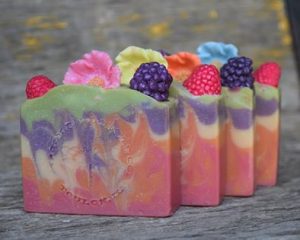
Glycerin comes after the safflower oils and before the water and lye water, so we’ll figure that the amount is right in between the two.
For the sake of argument and just to see how it plays out, we’ll say that the remaining 4 ingredients reduce by 1%, starting with the Sorbitol being present at 1% less than the lye. But these amounts don’t really make a difference, as you will see later.
Making the Calculations
Using formulas in an Excel spreadsheet to work out the possibilities, I tried various combinations of amounts for the oils. Finally I came up with the following possible formulation. I rounded to full percentage points and adjusted the amount of glycerin to make sure the total amount came to 100%. (Remember, these are just guestimates!)
In the chart below:
- The Percentage of MP soap is based on the calculations explained above.
- The ounces are figured out by multiplying the total weight of MP soap (10 oz) by the percentage of that ingredient.
- The percentage in the total is the percentage of the ingredient in the MP soap portion multiplied by the percentage that MP soap is of the whole batch (8%).
| Ingredient | % of MP | ounces | % in Total |
| Coconut Oil | 19% | 1.9 | 1.5% |
| Palm Oil | 16% | 1.6 | 1.3% |
| Safflower Oil | 16% | 1.6 | 1.3% |
| Glycerin | 11% | 1.1 | 0.9% |
| Sodium Hydroxide | 8% | .8 | 0.6% |
| Water | 8% | .8 | 0.6% |
| Sorbitol | 7% | .7 | .6% |
| Propylene Glycol | 6% | .6 | .5% |
| Sorbital Oleate | 5% | .5 | .4 |
| Oat Protein | 4% | .4 | 0.3% |
| Total | 100% | 10 oz |
Final Ingredient List

So now we can put together our final ingredient list, based on the percentage of each ingredient in the CP portion and MP portion. Where the same ingredient is included in both the CP and MP soaps, the percentages of the total are added together to get the total percentage in the total batch:
| Ingredient | % in Total |
| Coconut Oil (25.2% in CP + 1.5% in MP) | 26.7% |
| Olive Oil | 25.2% |
| Palm Oil (21.0% in CP + 1.3% in MP) | 22.3% |
| Sodium Hydroxide (10.9% in CP + .6% in MP) | 11.5% |
| Water (6.7% remaining in CP + .6% in MP) | 7.3% |
| Castor Oil | 2.9% |
| Safflower Oil | 1.3% |
| Glycerin | 0.9% |
| Sorbitol | 0.6% |
| Propylene Glycol | 0.5% |
| Sorbital Oleate | 0.4% |
| Oat Protein | 0.3% |
Notice what happens: Even when you add in the amounts from the MP soap, it doesn’t change the order of the CP soap ingredients and all the MP soap ingredients that aren’t already in the CP soap end up in the same order at the end of the list. Even if the guestimates were slightly off, it shouldn’t affect the order of the ingredient declaration much, if at all.
This may not always be the case; it will depend on the recipes for each type of soap and the amount of each type of soap used. If our final hybrid soap was 60% CP and 40% MP, the numbers would come out quite differently… but the forumlas for calculating would be the same!
Remember, too, that when using the alternate method of listing ingredients, all the ingredients that are present at 1% or less may be listed in any order after the ingredients present at more than 1%. So if we’re slightly off on the sorbitol, propylene glycol, sorbital oleate, and oat protein, it won’t make any difference.
Color Additives
In the alternate ingredient listing, color additives may be added at the end, after ingredients present at less than 1% regardless of the amount. So even if you used 5% titanium dioxide or 2% mica (not that I am recommending either of those very high amounts), it wouldn’t matter. They would just go at the end of the list.
Keep in mind, though, that only color additives that are approved for use in cosmetics may be listed this way.
Final Ingredient List
So, based on all the calculations above, this would be our final ingredient list (with several color additives and fragrance at less than 1% added so you can see where they would go):
Ingredients: Coconut oil, olive oil, palm oil, sodium hydroxide, water, castor oil, safflower oil, glycerin, fragrance, sorbitol, propylene glycol, sorbital oleate, oat protein, mica, titanium dioxide, ultramarines and FD&C Blue 1
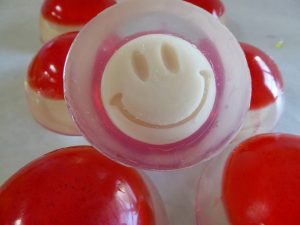

Shameless plug!
To really be able to create your own labels that comply with the regulations, get my book from Amazon and use it.
4th Edition – Released March 5, 2025!!!
Or order directly from me (and get a signed copy)!

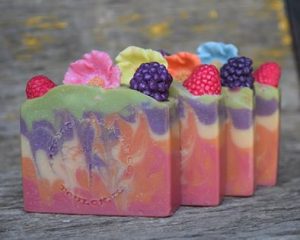
Leave a Reply